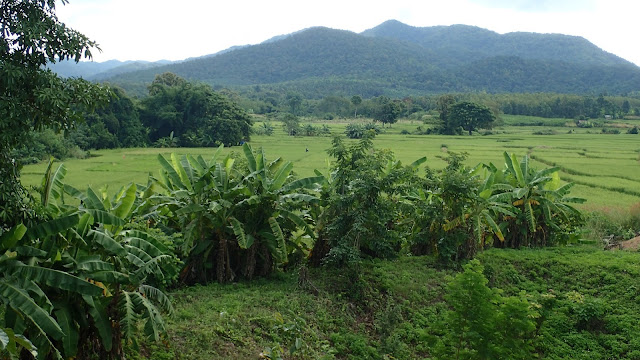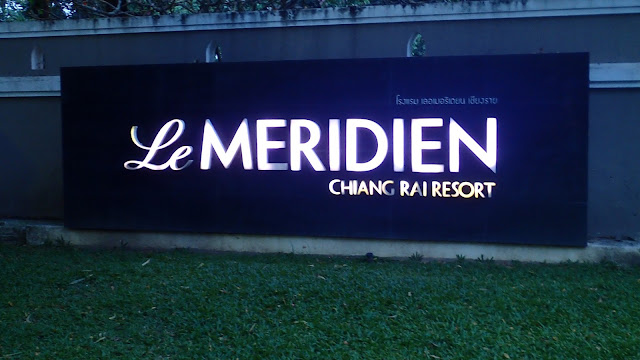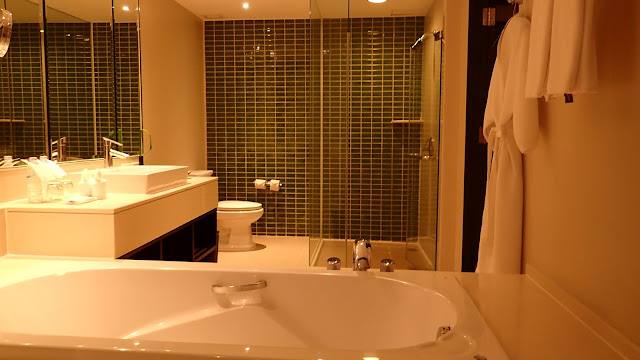Our hotel in Sukhothai was off by itself, completely away from town, so eating at the hotel was our only option.
 |
| The view across from our hotel. So beautiful but not a lot of dining options |
As always, breakfast was included in our stay and was offered from 6:00 am to 10:00 am. It was very good, so the fact that it was our only option wasn't a problem.
We didn't get into our hotel until late last night, so I wasn't able to take pictures until this morning. It was exciting to walk out my hotel room door this morning and see this beautiful organic garden that they use in the restaurant. That makes me happy!
 |
| Right outside my front door! |

 |
| The front of the hotel |
 |
| One of the pools |
 |
| The hotel is indoor/outdoor, with beautiful walkways throughout |
 |
| The reception area |
 |
| The lily ponds |
 |
| The dining room in the background |
 |
| The other pool |
 |
| The bar, she is straightening up for the day |
 |
| The library and wi-fi area |
After we finished breakfast and I did a little picture taking, we departed Sukothai and took a scenic drive to Chaing Rai, the northernmost province of Thailand.
Our luggage always travels separate from us and since we make so many fun stops along the way, it is always waiting for is in our room with we get to our next hotel.
 |
| Each morning we just take a quick look to make sure that our luggage got picked up, and then we can load the bus |
 |
| Pong, the taller man is our driver, and Yut is our bus boy. They take great care of us everywhere we go. |
We rotate seats each day to ensure that everyone gets their turn at the front of the bus and today was our turn to have the front seat. Mike always points out interesting facts to us as we drive along, and one of our interesting facts today was that trash cans in northern Thailand are made from worn out tires. This was the governments way of finding a useful purpose for them.
Our drive today was only 250 miles and the roads are great, but it takes a long time to go that far because there is a lot of traffic on the highways so we are always waiting to pass something.
 |
| Some sort of farm tractor |
 |
| Rather common traffic on the highways in northern Thailand |
 |
| More traffic to try to get through |
 |
| Even the dogs get in on the action |
The drivers are very courteous, and if they are going too slow, they will help the car (or bus in our case) behind them to pass them safely by using their blinkers and brake lights.
Because of the neighboring countries that Thailand shares borders with, there has been a problem with drug trafficking in northern Thailand. About 300 tons of drugs come through Thailand each year, with about 250 tons coming in from Burma (now Myanmar) and the other 50 tons coming in from Laos. So as we moved further north, we saw more and more drug check points. About 30 years ago, the drug lords had control of Chiang Rai, but they now have it under control. There is now a death sentence for selling or trafficking drugs in Thailand.
 |
| One of many drug checkpoints we encountered as we got further north in Thailand |
Steve asked Mike about health insurance in Thailand, and he told us that it costs about 600 baht per year. If you have a small procedure, you usually pay it out of pocket, but larger procedures are covered. There is also an allowance of 3000 baht per night if you are admitted to the hospital.
 |
| The farmland of northern Thailand is so pretty |
As we headed north, we also started seeing a lot of teak wood trees. For a long time in Thailand, the lumber industry of teak had been out of control, removing many of the large teak trees from the area, but the government finally put a stop to it, and made lumbering of wild teak illegal. Awhile after teak lumbering was outlawed, the government decided that they would allow Thai people to remove the stumps of teak trees that had been previously cut, so Thai people started getting creative, and using the stubs and roots of the old trees to create furniture. So another one of Mikes surprises was to stop at one of these furniture shops to look at the very unique furniture.
 |
| The first thing I noticed as we entered the workshop was dinner on the grill. A huge toad. |
Also along the road, we kept seeing plants that kind of looked like marijuana, although we knew that they weren't. We finally asked Mike what they are, and he said that they are tapioca plants.
 |
| A tapioca field |
 |
| The leaves up close |
So we also stopped at a tapioca farm. Mike and Yut pulled up a tapioca plant to show us the root. The root is what is used to make the tapioca. It can be easily peeled, and must be crushed and exposed to the sun to release sianide that is naturally found in the root. Once the root is allowed to dry for awhile it can be ground into tapioca flour.
 |
| Mike and Yut pulling up a tapioca plant to get to the root |
 |
| Mike showing us the tapioca root. They are usually much longer, but they broke this one off |
And there was a huge termite hill also
We also saw mushroom stands on the side of the road
And bamboo sticks lying by the road to dry. They will be used for weaving baskets
My favorite sighting though was a water buffalo. They used to be very common in northern Thailand since they were used to pull the farming equipment. But now machines have replaced most of them.
 |
| Steve holding the weight of Buddha in his hand |
Our lunch stop today was almost 1/2 way to Chiang Rai in the town of Phrae which is known for teak wood and furniture. We went to an out of the way little restaurant where they had set up a nice area for us, kind of off by ourselves. They brought out several different dishes for lunch, including rice, pork omelet, stir fried vegetables with shrimp, broccoli with beef and snow peas and fruit for dessert.
 |
| Our lunch spot |
 |
| All set up and ready for us |
Mike and our bus men ordered their own food, which was quite different than ours. It was prepared in Issan style and was much spicier than what we were eating. He called Steve and I over to take a try of it since he knows that we like spicy food. It was a green papaya salad that was delicious. I think we like it even more that what we were eating because it had a nice bite to it.
Mike said that if we are ever in the south of Thailand we need to order Plar Tod Namplar. It is fried shrimp in fish sauce and he said that he thinks we would like it a lot. He said to also try the steamed crab, but he warned us not to eat the crab in the north part of Thailand because it is often not cooked and will make us sick.
Our next stop was a home where they make clothing from indigo dye. To make the indigo dye, they mix ash in water in huge drums. The drums have very small holes in the bottom that allow the water to very slowly leak out. (This ash water is how they keep the dye from fading). They then mix the ash water with limestone and mix it by hand until it becomes foamy. They pour this mixture onto broken twigs from the ingido tree and let it sit for a long time. The indigo branches will eventually turn the water blue, and this becomes the dye. Next, they add a pattern to plain white fabric by dipping a metal stamp into hot parafin. They give it a hard shake, and then stamp the fabric. They continue this until an entire bolt of fabric has been stamped. Once the parafin cools, they dip the stamped fabric into the indigo dye. When they first pull it out, it looks green, but as it dries, it turns a beautiful blue.
Preparing the fabric:
 |
| A large stamp with hot parafin wax is stamped onto plain white fabric, usually in a pattern |
 |
| Here she is making a huge piece |
 |
| I am selecting my small piece of cloth to try stamping |
 |
| I'm stamping on the hot wax |
 |
| And ta da, a small elephant stamp |
Next we will make the natural indigo dye:
 |
| A branch of the indigo tree |
 |
| Water with ash soaking in it |
 |
| Mixing the ash water with limestone |
 |
| Soaking the indigo stems and leaves in the limestone water |
 |
| Dipping the waxed fabric into the indigo dye. When it first comes out, it has a green hue to it, but as it sits in the air, it turns blue. |
 |
| Hanging the fabric out to dry |
As we continued on our way through northern Thailand, we ran into some rain, and when it rains, it really rains.
Our next stop was for coffee and wine in the City of Phayao. This city has a beautiful lake, and would be a wonderful place to spend some time.
 |
| We'll take one of everything please |
The coffee shop we stopped at had very nice restrooms and fabulous coffee. They made the most beautiful designs in their hot lattes, and no two are alike!




After we finished our coffee, Mike had one of the local women prepare us a Thai delicacy called jumping shrimp salad. The woman first mixed up the spices in a bowl. It was a combination of roasted rice, coriander, onion, red chili and lime. She then added little tiny live prawns (they were about 1 inch long). They were prawns from Lake Phayao. She mixed them all up in the spices and many of them kept jumping out of the bowl, and then you just eat them....live.
 |
| We're all watching intently as she adds the shrimp |
 |
| Doesn't that look tasty? Unfortunately, you can't see them jumping but you can in the video below! |
 |
| It really wasn't bad, it just freaked me out! |
Steve and I both tried it, and it was actually delicious (which you certainly can't tell from my face), but I really didn't like them jumping in my mouth. That part bothered me a lot, but I'm really glad that I at least tried it.
The link below is pretty funny and shows everyone's reaction to the salad.
https://www.youtube.com/watch?v=s8GgPx7uaf4
We also asked Mike where the bus driver and bus boy stay at night. He said that they pull the bus into a place with electricity and showers, and that they bunk in the bus. They stay with their bus all night to ensure that nothing happens to it, but also it doesn't cost them anything that way.
Our final fun fact of the day is that it takes a banana tree about 3 months to produce bananas after you plant it. Once a stalk produces bananas, you cut it off at the ground and a new stalk will grow and produce more bananas.
We pulled into our hotel, Le Meridien in Chaing Rai at about 5:00, which gave us some time to ourselves before dinner. Dinner was a beautiful buffet served from 6:00 to 10:00 so we could explore the hotel a little bit and go down for dinner at our leisure.
It was a fabulous display of food to choose from.

Although all of our hotels have exceeded our expectations, Le Meridien is definitely the nicest of them all. We only have two nights here, so we will have to make the most of it.
We took a walk to look around the neighborhood, and we saw construction on a building down the block.
 |
| Bamboo scaffolding, many stories high |
We are truly loving our time in northern Thailand!




















































































No comments:
Post a Comment